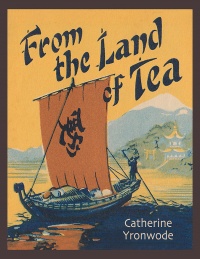From Mystic Tea Room
England Tea Room Gallery, in alphabetical order by name of city or town.
In this installment of "From the Land of Tea," we take a sneak-peek look at an upcoming page that will eventually be on display to the public. As a Patreon supporter, you have access to the page one full year before the public does.
- Patreon Release Date: November 28th, 2021.
- Public Release Date: November 28th, 2022.
Please tell your friends that they can subscribe to my Patreon stream for $2.00 per week:
Patrons: To discuss this and other Patreon pages with me, join my private Patreon Forum:
Today's topic is again Tea Rooms by Location. These are old postcards, and each one has a caption explaining it, and some have additional text. These images will eventually be on display at the Mystic Tea Room web site. As a Patreon supporter, you have access to them one full year before the public does.
To place this work in context, please read the following introductory pages
England
English tea rooms are among the oldest found outside of Asia. Their popularity predated the great Tea Room craze of 1895 to 1945, but like their American counterparts, they were often retrofitted into historical buildings, including cottages, houses, barns, granaries, mills, inns, taverns, and hotels. Because England is a region of cold and damp winters, these older buildings were often outfitted with fireplaces in every room, and thus, in England at least, a fireplace was to be found in almost every tea room.
The word most often used to describe such tea rooms is "cozy" -- and cozy is a word whose literal meaning is "warm." When postcards were made to publicize such local tea rooms, it was quite natural for the photographer to focus on the fireplace or to feature it prominently in the composition.
Not all of the tea room postcards in this lot are interior views, but those that are often contain fireplaces. Many of these cards are also RPPCs -- real photo postcards.
Cornwall
Penzance
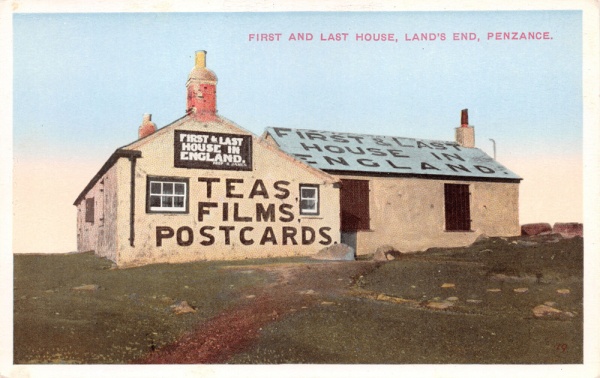
First and Last House in England, Land's End, Penzance, Cornwall, England, offering Teas, Film, and Postcards. The First and Last House in England is an unusual tourist destination; the name refers to the fact that it is the farthest west structure on the island, and thus to first to be sighted when approaching England from the Atlantic Ocean and the last to be seen when sailing west. Signage on the exterior walls and roof has changed many times over the past 100 years, but tea is always available, and in summer there are ices. This photo was probably taken and tinted in the 1920s, and the building still stands.
Polperro
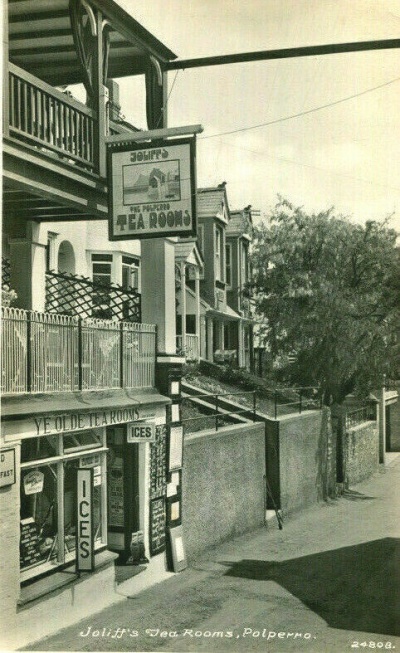
Joliff's Polperro Tea Rooms, Polperro, Cornwall, England. This exterior photo of signage for "Joliff's, The Polperro Tea Rooms" and "Ye Olde Tea Rooms" selling "Ices" displays the quaint architecture of this seaside town. The card dates to the 1910s or 1920s and a quick glance at Google street view shows that the building and row of houses was still standing 100 years later, in 2021.
Devon
Braunton
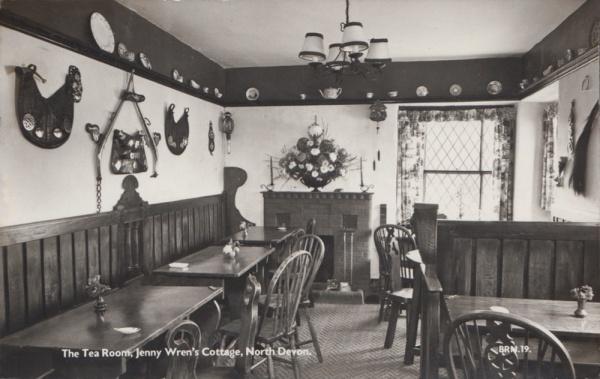

The Tea Room, Jenny Wren's Cottage, Braunton, North Devon. This card has proved to be a bit of a mystery. The photographer's code at lower right indicates that this is the 19th image taken in Braunton, a town in Devon. Jenny Wren is a common rural name for the House Wren, and is also the name of a character in Charles Dickens' 1865 novel "Our Mutual Friend." In the novel, Jenny Wren (whose real name is Fanny Cleaver) is a pretty but physically disabled young woman who cleverly supports herself and her alcoholic father as a dolls' dressmaker. Along the way she befriends a kindly Jewish man, and by the novel's end it is hinted that she has found love with an orphaned young man and that they may marry. "Jenny Wren's Cottage" is a popular name for small rural houses in England, and at the present time there is a cottage of that name in Knowle, a hamlet adjacent to Braunton. However, it is unclear to me if the current Jenny Wren's Cottage in Knowle, which is not a tea room, is indeed this cottage. In any case, whether the Tea Room at Jenny Wren's Cottage was named for the bird or for the lovably eccentric character in the novel, it is a charming little room with a cheery fireplace and diamond-mullioned windows, its walls festooned with a great deal of horse tack and a multitude of lucky horse brasses.
Moretonhampstead
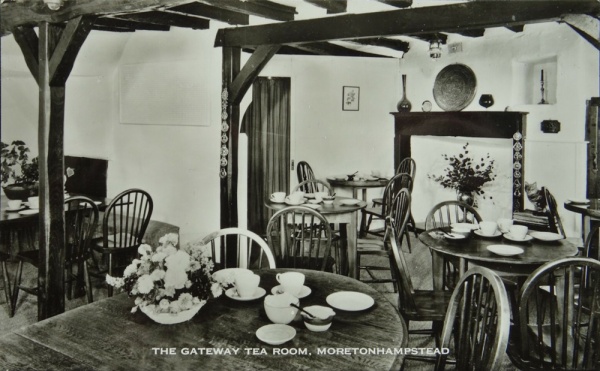
The Gateway Tea Room, Moretonhampstead, Devon, England. A bowl of white roses on a table and a large brass vase filled with blooming branches set into the fireplace hearth inform us that this photo was taken in summer. The wooden fireplace surround is quite similar to the 15th century fireplace in the Novelty Store Tea Room in the same town of Moretonhampstead, directly below. An array of antiquities adorns the mantelpiece and a leather strap strung with lucky horse brasses ornaments one side of the mantel frame.
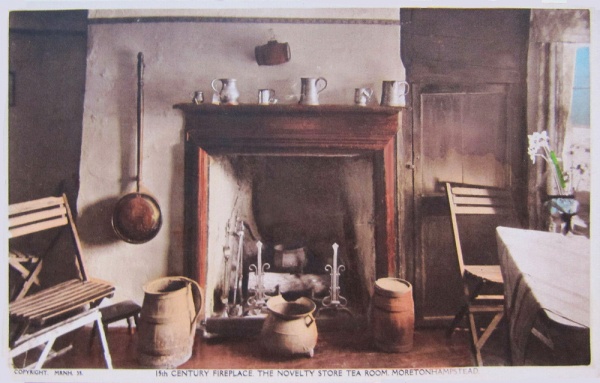
15th Century Fireplace, Novelty Store Tea Room, Moretonhampstead, Devon, England. Here is a card that mystifies me. It is strange enough for a Novelty Store to host a tea room, but how unlikely is it for the tea room to house a 15th century fireplace? In the English manner, the fireplace hearth is the center of attention in the tea room, and here we see the andirons, fire tools, brass warming pan, and a decorative array of pewter tankards on the mantelpiece. The tea table and garden furniture almost look like an afterthought, against the wall under a sunny window, ornamented with a casual vase of Narcissus flowers.
Woolacombe
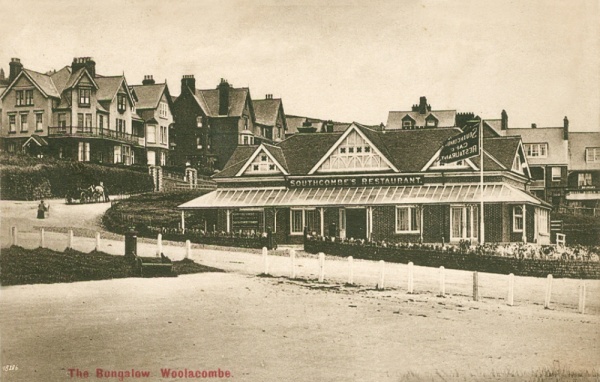
The Bungalow Tea Room, Woolacombe, Devon, England, also known as the Bungalow Café Restaurant, Southcombe's Restaurant, and The Red Barn. This description comes from the "North Devon Journal" of Thursday, May 31st,1906: "A new refreshment room was opened at Woolacombe on Monday by Mr. G. Southcombe of Ilfracombe. The building is a fine detached block, right in the centre of the village, and fronting to the sea."
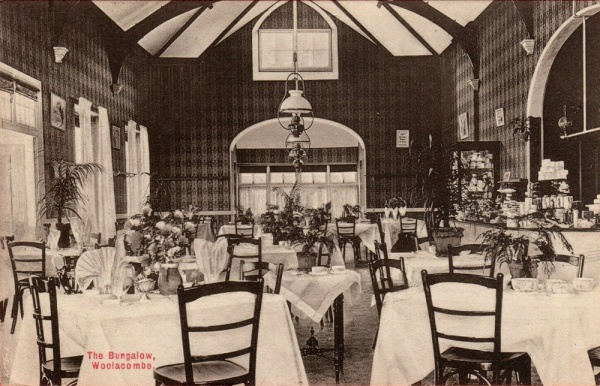

The Bungalow Tea Room, Woolacombe, Devon, England, also known as the Bungalow Café Restaurant, Southcombe's Restaurant, and The Red Barn. With its potted palms and fan-folded napkins, The Bungalow presents an upper-crust atmosphere akin to fancy hotel tea rooms of the era. Continuing from the "North Devon Journal" of Thursday, May 31st, 1906: "The principal room is a very fine one, 72 feet long, 25 feet wide, with an arched ceiling rising to 25 feet at the apex. It has four large windows in front, and at each end is a fine alcove with a large window, and there is also a window in each gable. In the centre opposite the entrance is a large semi-circular counter of polished wood, while the woodwork throughout the room is enamelled in white. The walls are covered with a tasteful art paper in green and red and the floor with artistic Staines linoleum. There will be accommodation at tables of various sizes for over 150 visitors, and every description of confectionary and refreshments will be served. The whole of the china used is of a very fine rose pattern. The room has two handsome fireplaces, and is lighted by six large lamps of the Veritas pattern. Opening out at the back of the room are lavatories for ladies and gentlemen, fitted with hot and cold water, and large mirrors. From the back of the counter are reached the store room, having ten large cupboards, the dairy and larder, kitchen, wash up room, and sitting room, while bedrooms are provided above. There is a back entrance to the premises, and along the whole frontage is a verandah, six feet wide. Beneath the dining room and entered from outside is a cycle rest, where a good number of cycles can be stored. Mr. G. Southcombe, Junior, takes charge of the business, which provides accommodation of the most modern kind, hitherto lacking in this favourite resort for day visitors. We wish the new venture every success."
Gloucestershire
Tewkesbury
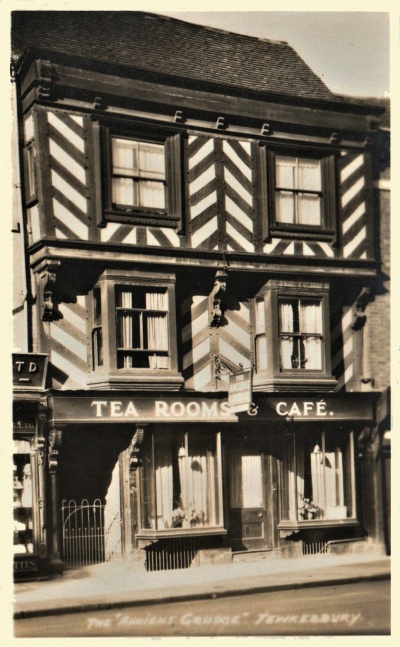
The "Ancient Grudge" Tea Rooms and Cafe, Tewkesbury, Gloucestershire, England. The "Ancient Grudge" was the enmity between the Houses of York and Lancaster, which brought about the Battle of Tewkesbury in 1471. I grew up in California, where we call this style of half-timbered architecture "Tudor," but ours is only Pseudo-Tudor; this is the real deal, built in the early 16th century and re-fronted in the late 16th century. The building, at 15 High Street, still stands.
Greater London
London
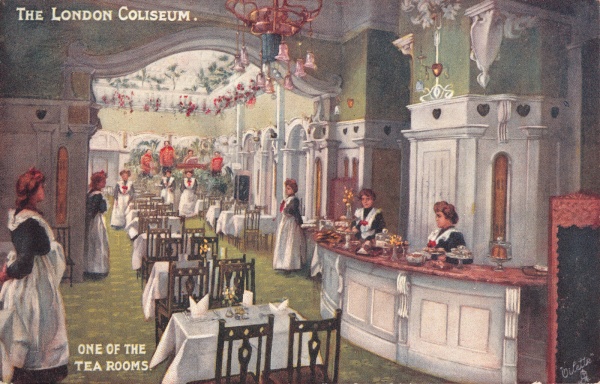
London Coliseum, One of the Tea Rooms, interior, Tuck Oilette postcard front.
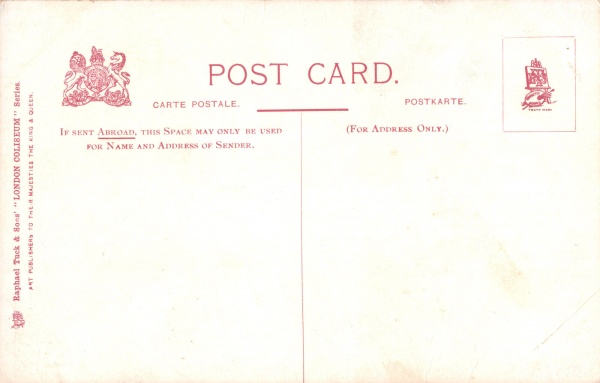
London Coliseum, One of the Tea Rooms, interior, Tuck Oilette postcard back.
Hampshire
Beaulieu
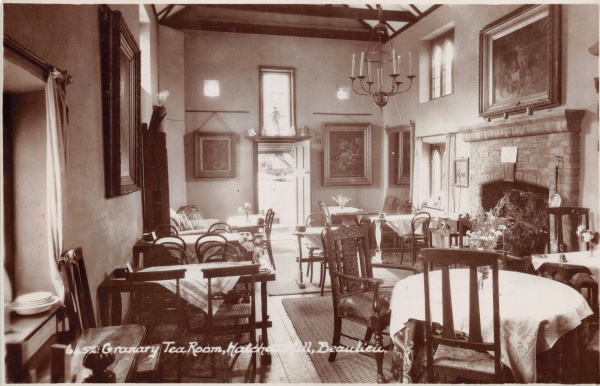
Granary Tea Rooms, Hatchett Mill, Beaulieu, Hampshire, England, postcard front.
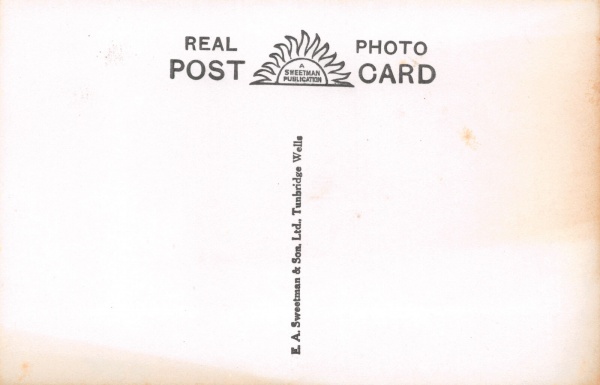
Granary Tea Rooms, Hatchett Mill, Beaulieu, Hampshire, England, postcard back.
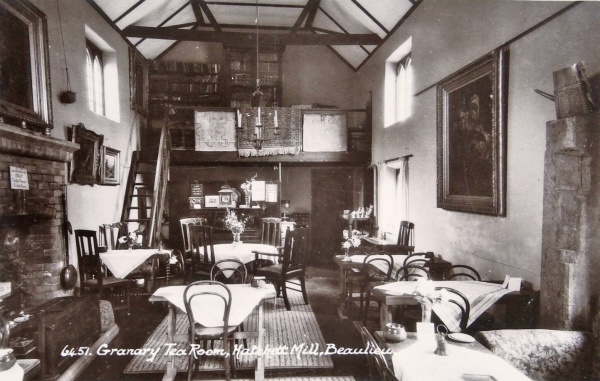
Granary Tea Rooms, Hatchett Mill, Beaulieu, Hampshire, England, postcard front.
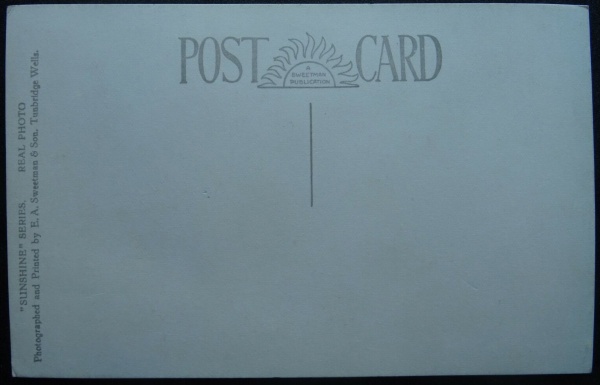
Granary Tea Rooms, Hatchett Mill, Beaulieu, Hampshire, England, postcard back.
Burley
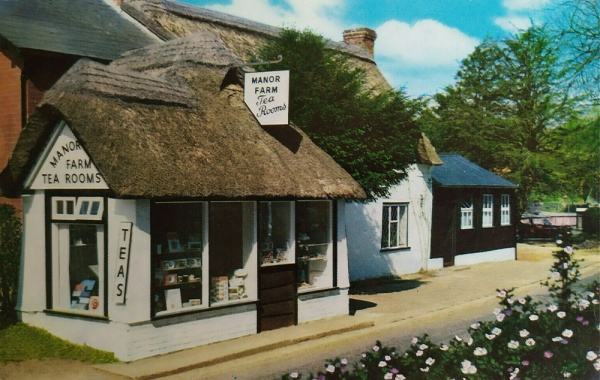
Exterior of Manor Farm Tea Rooms, Burley, New Forest, Hampshire, England; the ancient thatched cottage dates to the 16th century, according to the text on the back of this colour photo postcard from 1945. Directly below is an interior shot of the old fireplace.
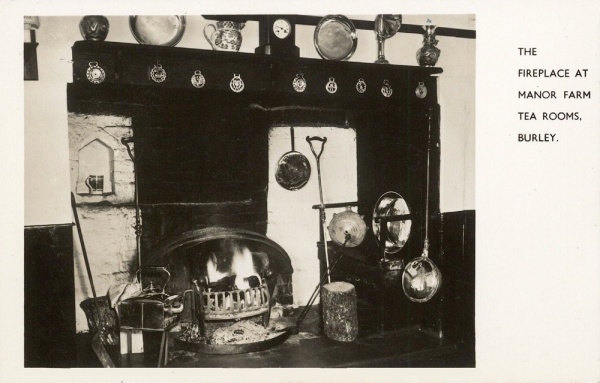
The Fireplace at Manor Farm Tea Rooms, Burley, New Forest, Hampshire, England; the tea tables are not seen, but the focus is on a very ancient fireplace around which we see a grouping of fire tools, polished brass warming pans, an unusual rectangular brass tea kettle, and some firewood. Along the front of the mantelpiece, nine lucky horse brasses are nailed; atop the mantel a clock, two brass trays, an ornate candle-stand, and some pottery can be seen; one piece seems to be a jug in the old Blue Willow pattern.
Ringwood
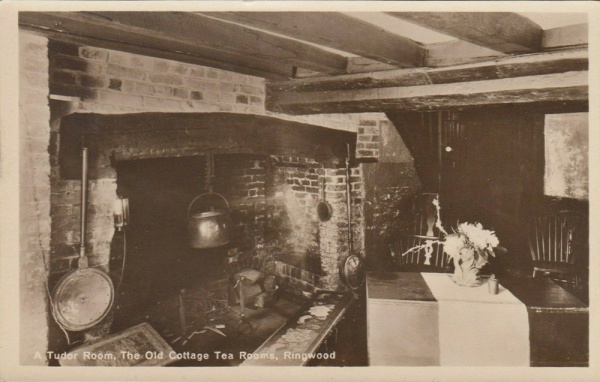
A Tudor Room, Old Cottage Tea Rooms, Ringwood, New Forest, Hampshire, England. The plural form, "Tea Rooms" is quite common in England and is used specifically to convey the information that a multi-roomed building — perhaps an old home, historic agricultural structure, or a shop — has been outfitted with several small tea rooms, each featuring its own decor. This is "a Tudor Room," and as is often the case, the photo features an old fireplace. Here we see the andirons, fire tools, brass warming pans, and kettle -- but no cheerfully flaming logs or grate of coal. because as the vase of flowers tells us, the photo was taken in summertime.
Warwickshire
Kenilworth
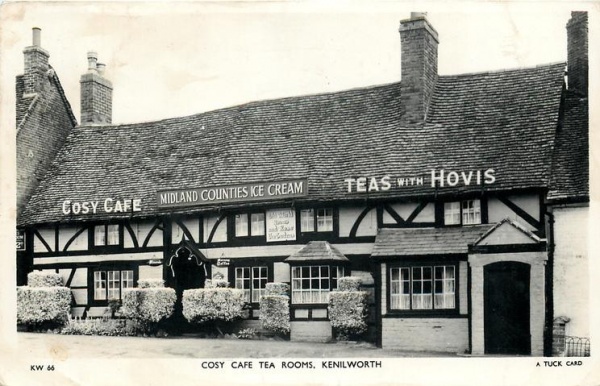
Cosy Cafe Tea Rooms, Kenilworth, England, exterior, Tuck postcard front.
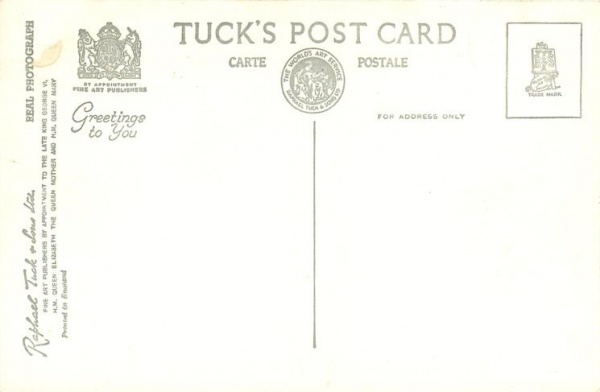
Cosy Cafe Tea Rooms, Kenilworth, England, exterior, Tuck postcard back.
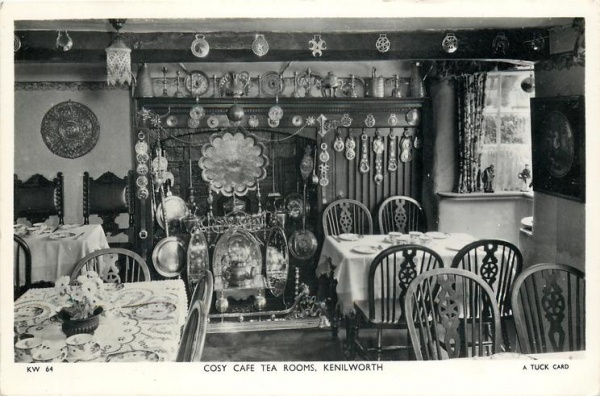
Cosy Cafe Tea Rooms, Kenilworth, England, interior, Tuck postcard front. The collection of horse brasses is delightful; notice also the china ware.
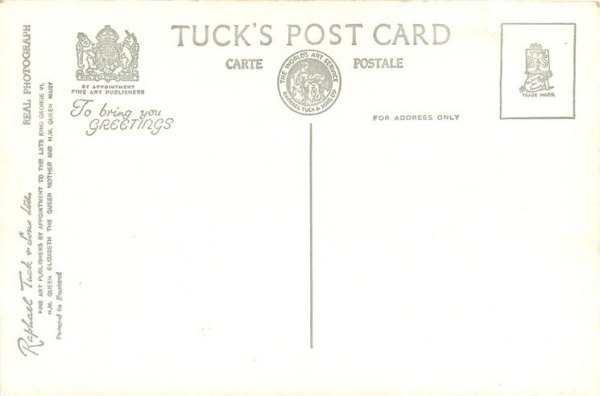
Cosy Cafe Tea Rooms, Kenilworth, England, interior, Tuck postcard back.
catherine yronwode
curator, historian, and docent
The Mystic Tea Room
See Also










